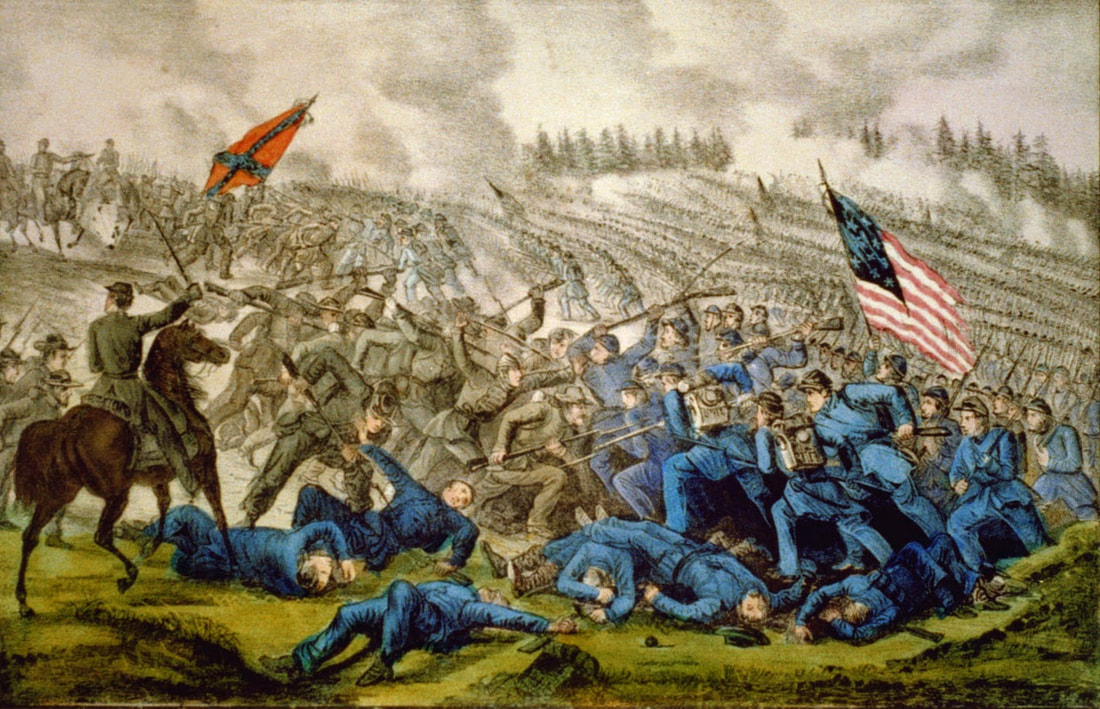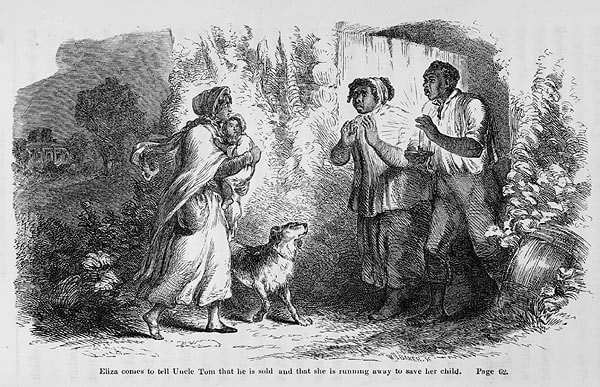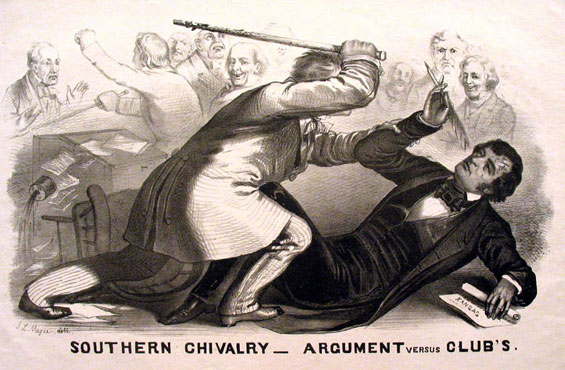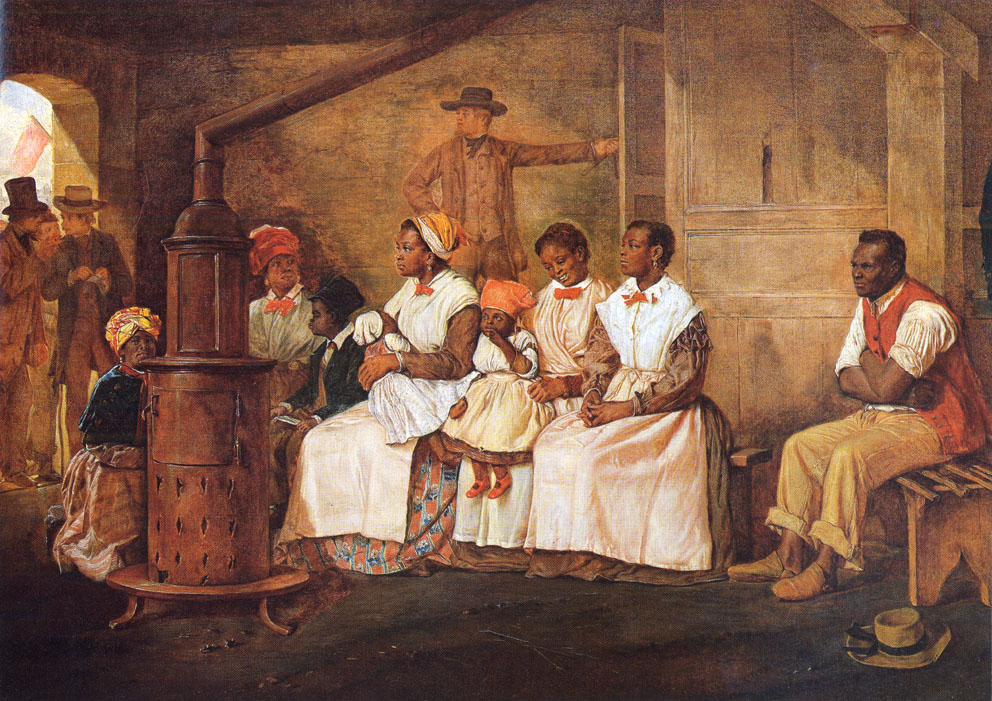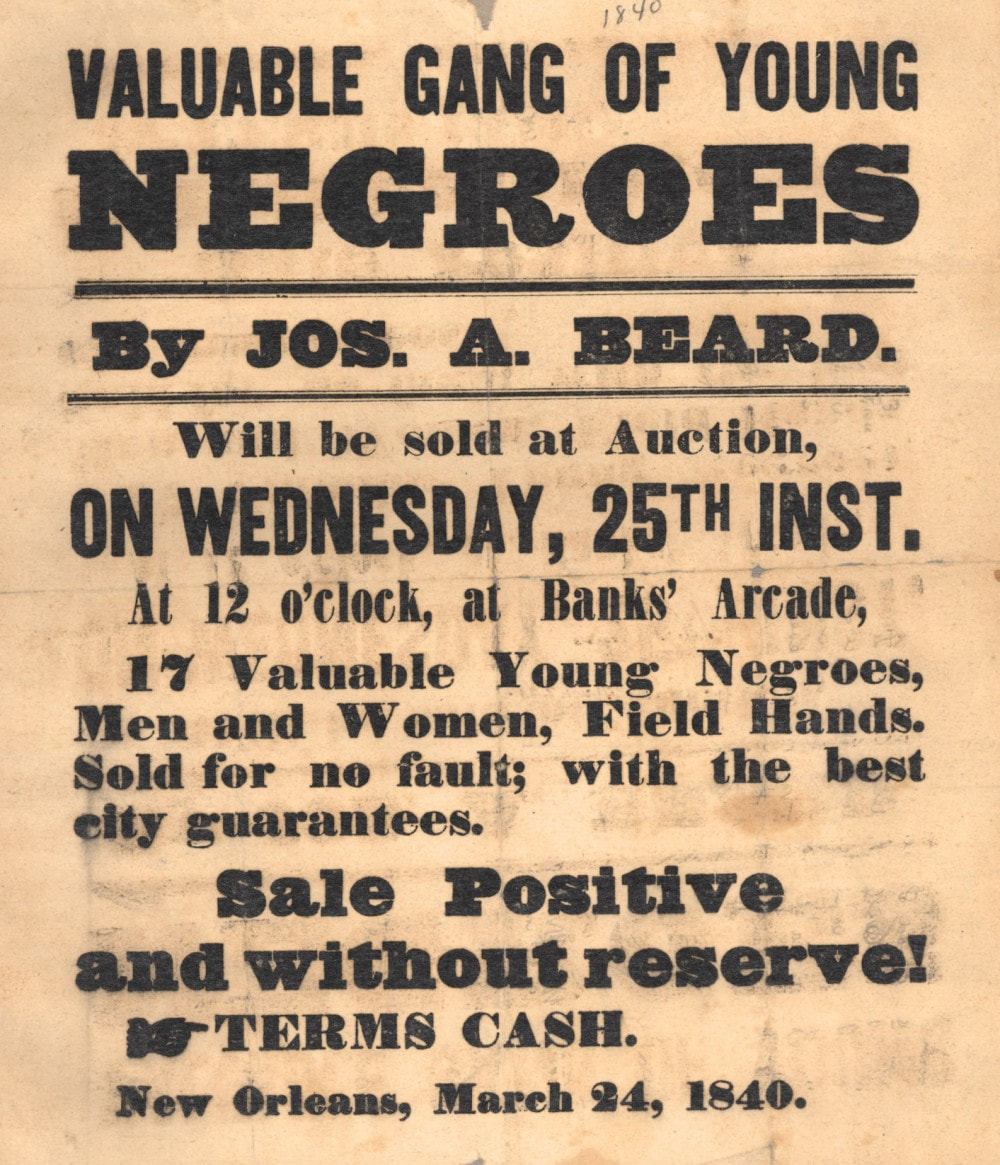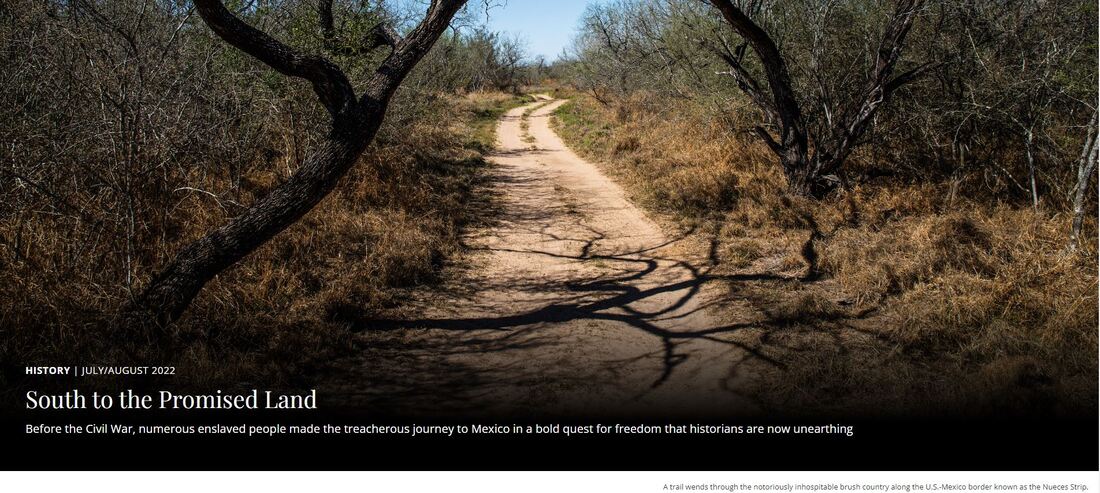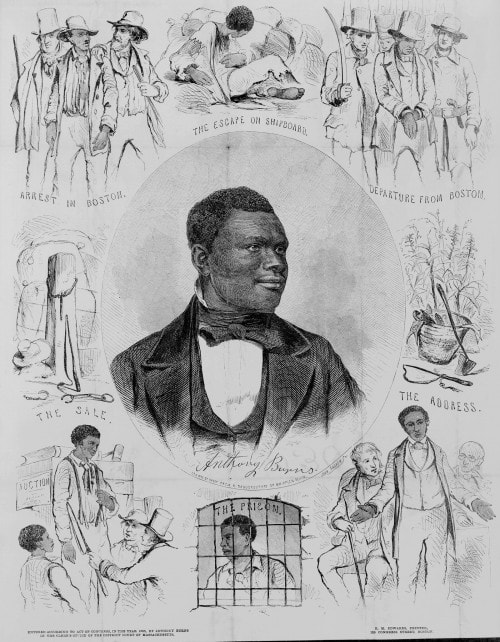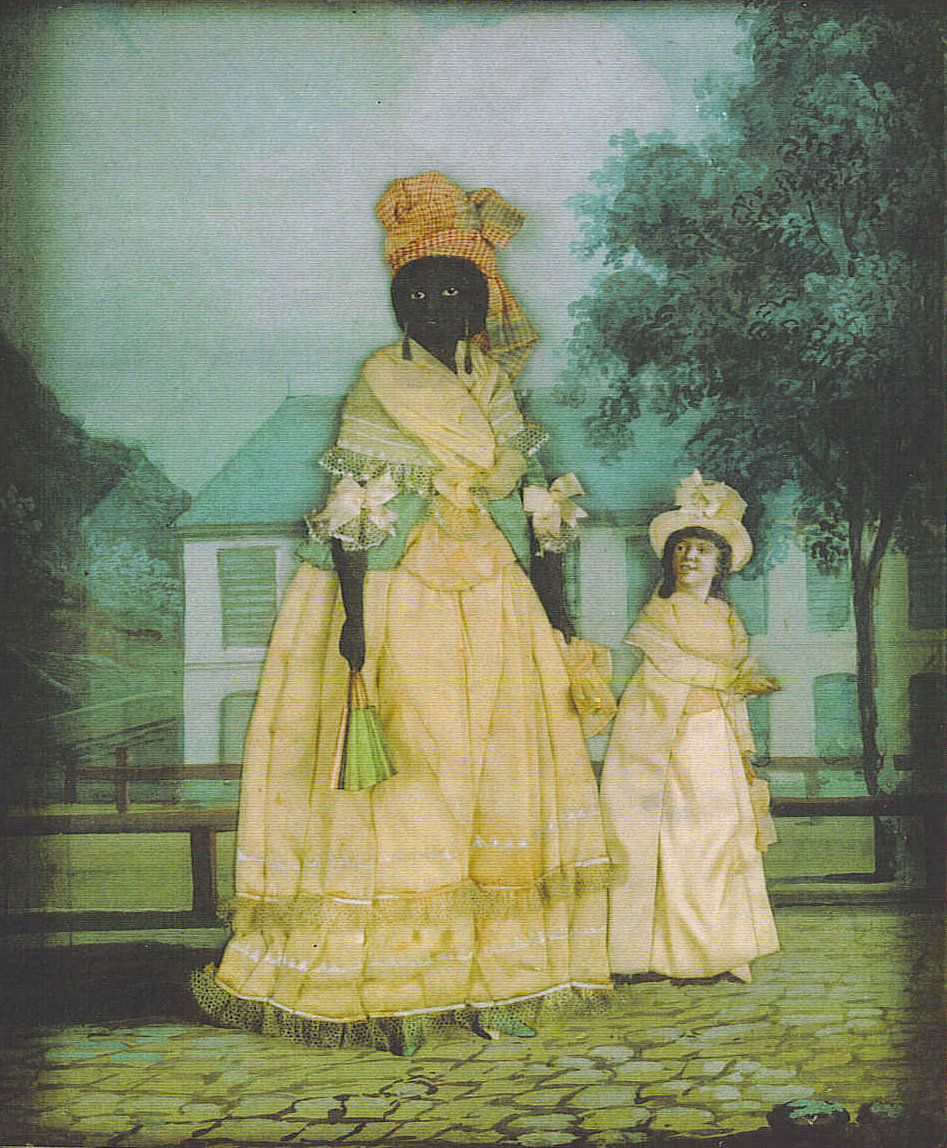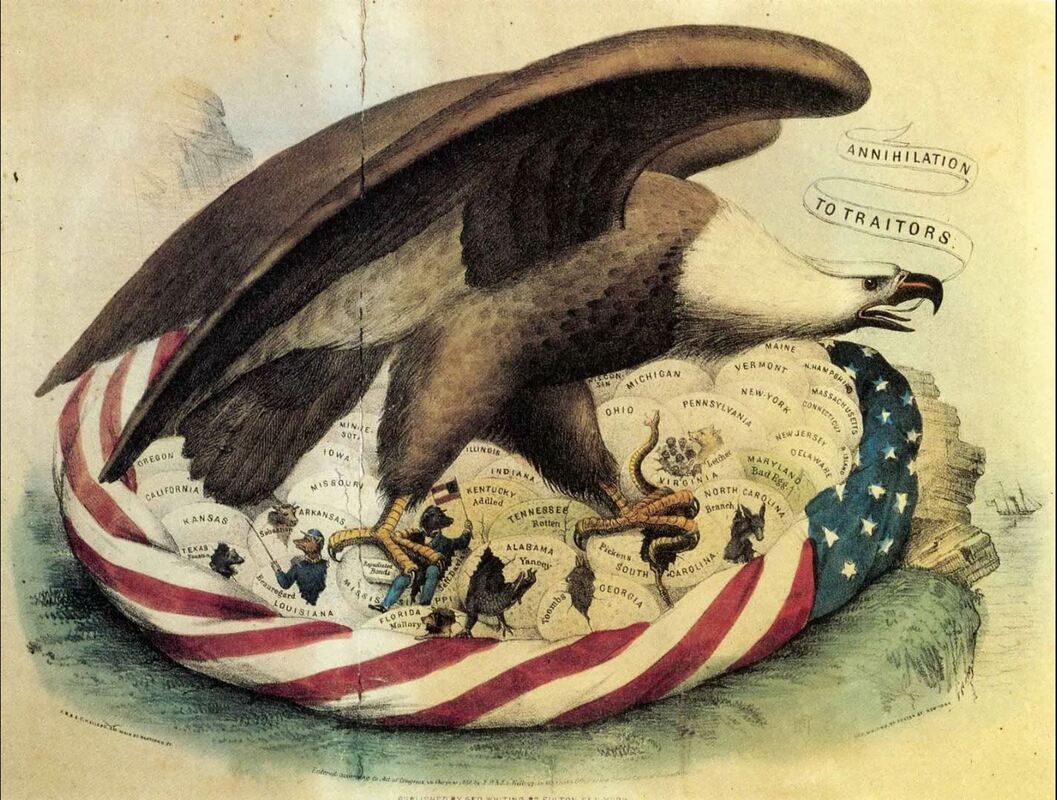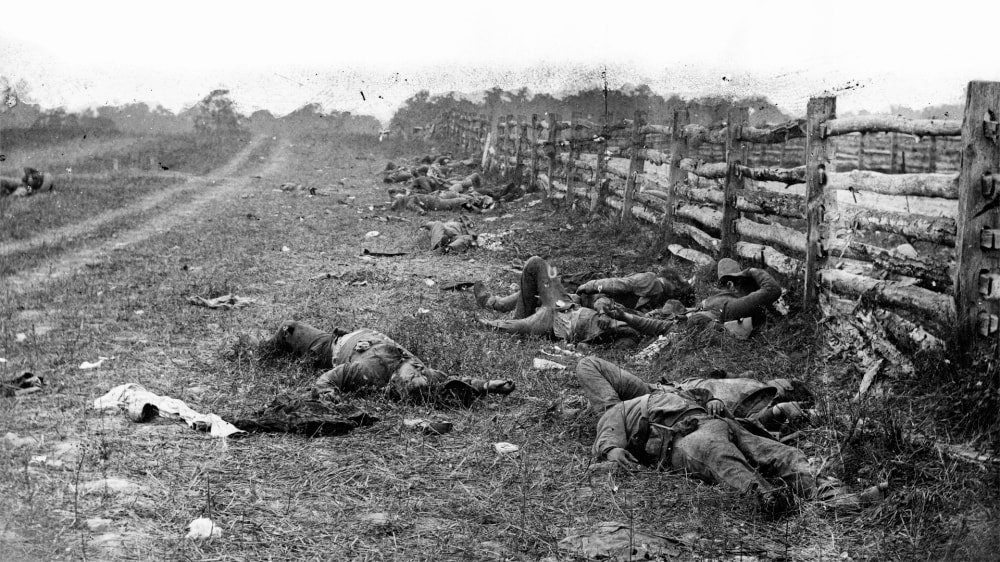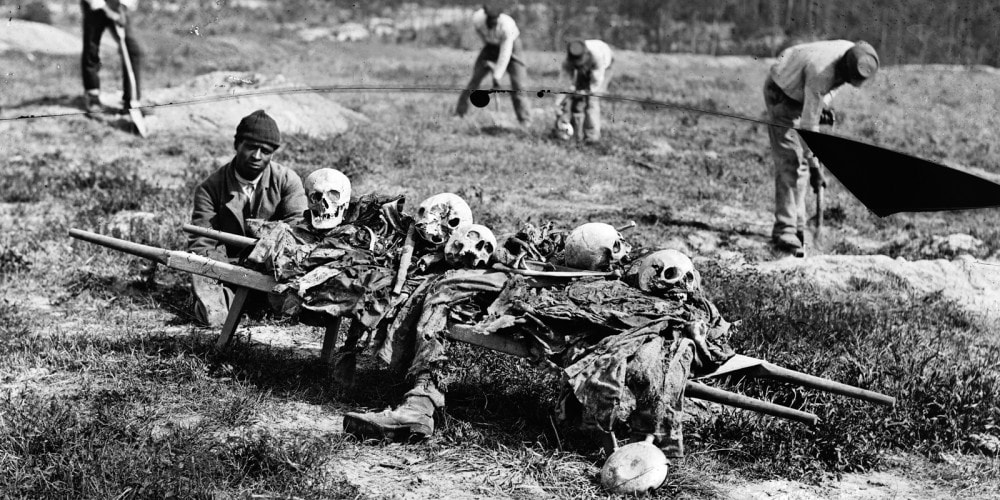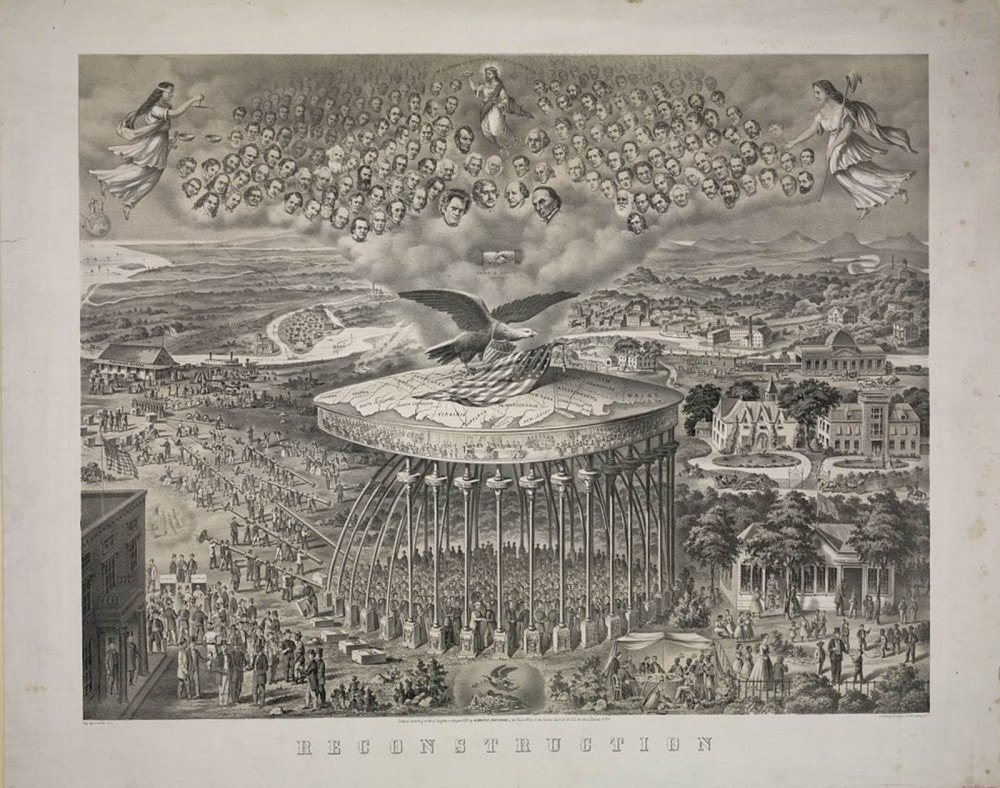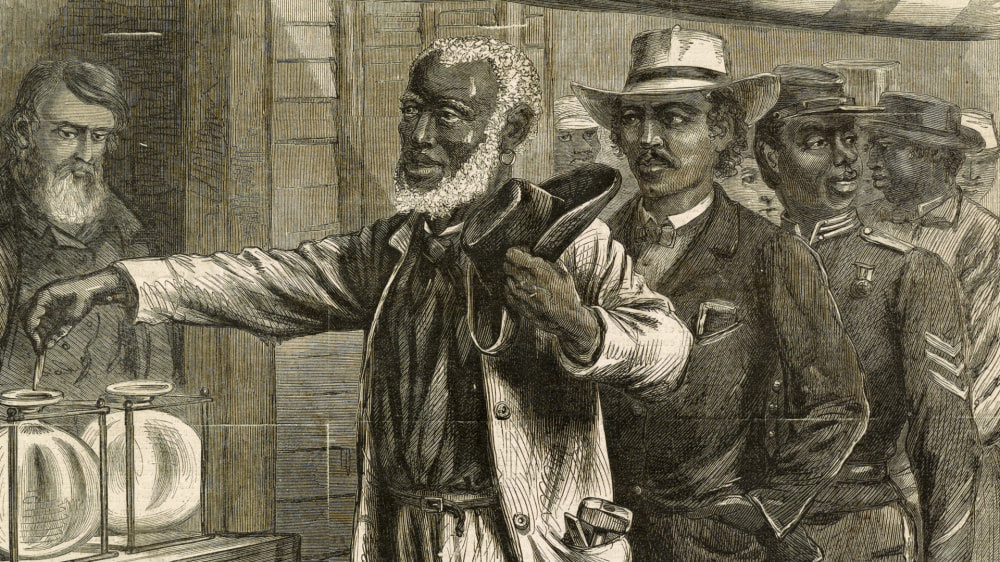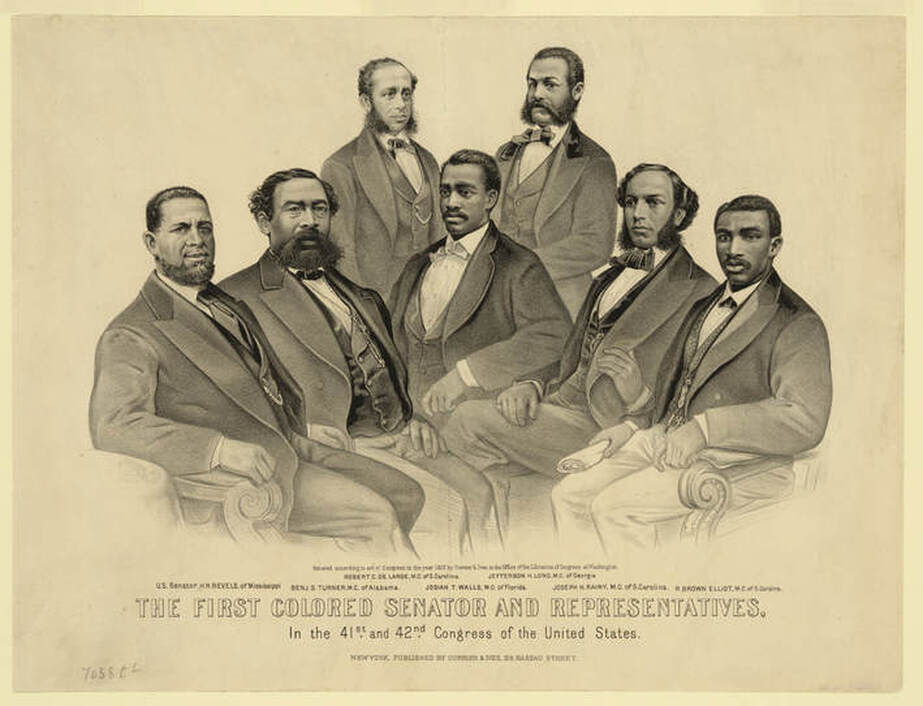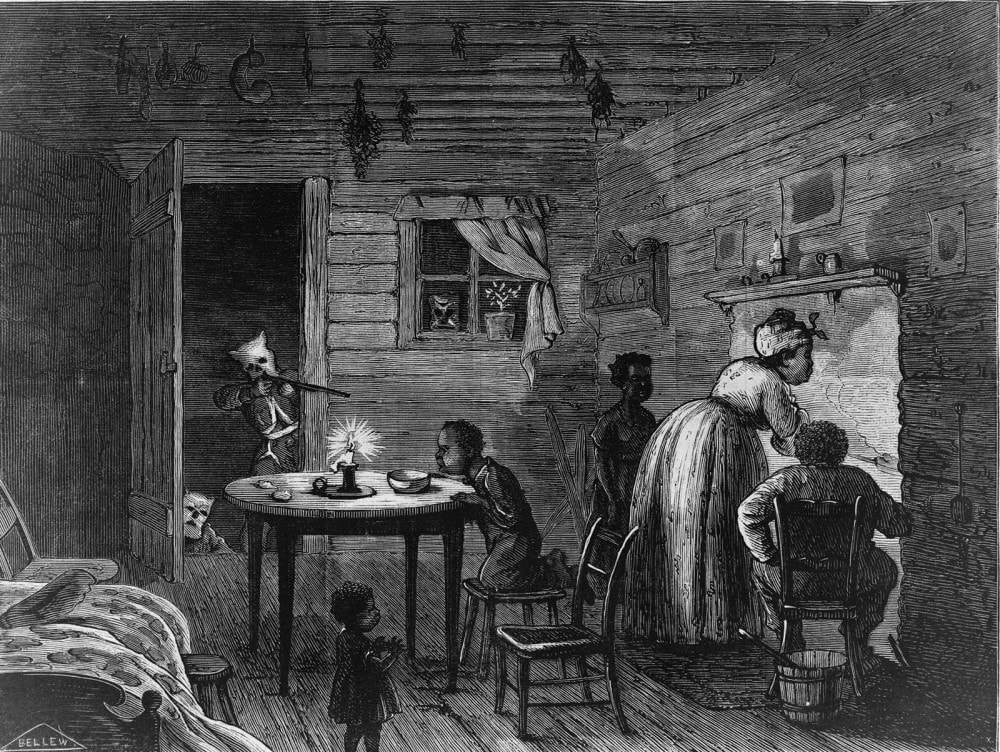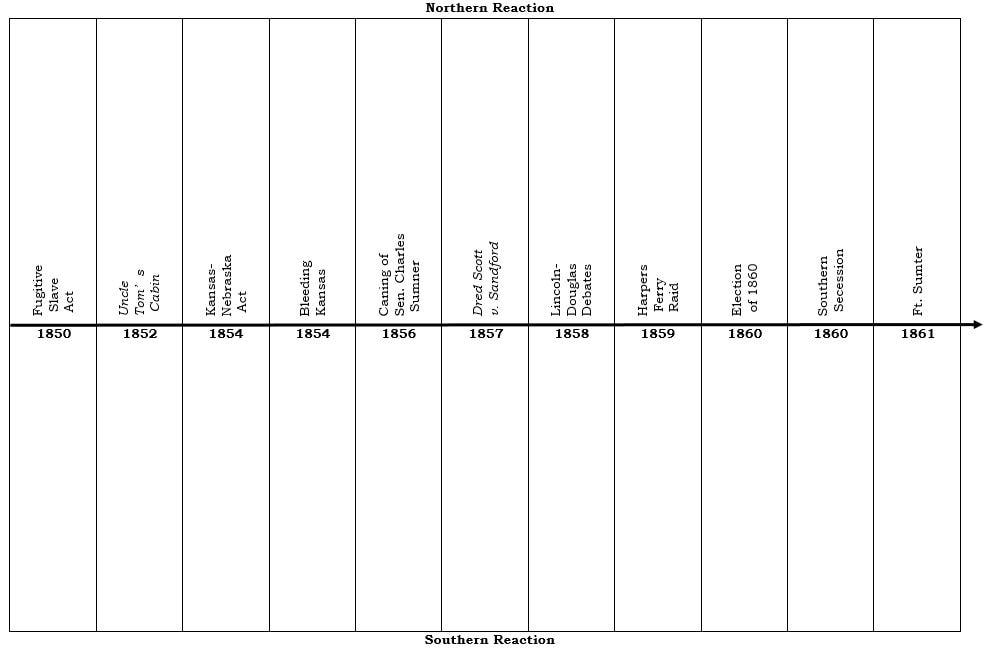The Civil War
1840s-1870s
Contents
The Civil War, 1840s-1870s:
Civil Crisis
|
Illustration for the first edition of Uncle Tom's Cabin (1852). Eliza tells Uncle Tom that he has been sold and she is running away to save her child.
|
Anthony Burns, the fugitive slave, appears in a portrait at the center of this 1855. Burns’ arrest and trial, possible because of the 1850 Fugitive Slave Act, became a rallying cry. As a symbol of the injustice of the slave system, Burns’ treatment spurred riots and protests by abolitionists and citizens of Boston in the spring of 1854. John Andrews (engraver), “Anthony Burns,” c. 1855.
|
National Review - Five Things They Don’t Tell You about Slavery
Free people of color were present throughout the American South, particularly in urban areas like Charleston and New Orleans. Some were relatively well off, like this femme de couleur libre who posed with her mixed-race child in front of her New Orleans home, maintaining a middling position between free whites and unfree blacks. Free woman of color with quadroon daughter; late 18th century collage painting, New Orleans
|
Review:
- How did Congress try to resolve the dispute between North and South over slavery?
- How did the Fugitive Slave Act and the Kansas-Nebraska Act increase tensions between the North and South?
- What developments deepened the divisions between North and South?
Civil War
Review:
- How did the Union finally collapse into a civil war?
- How did each side’s resources and strategies affect the early battles of the Civil War?
- How did the Emancipation Proclamation and the efforts of African American soldiers affect the course of the war?
- How did the Civil War bring temporary and lasting changes to American society?
- How did the Battles of Vicksburg and Gettysburg change the course of the Civil War?
- What was the final outcome and impact of the Civil War?
Reconstruction
While no one could agree on what the best plan for reconstructing the nation would be, Americans understood the moment as critical and perhaps revolutionary. In this magnificent visual metaphor for the reconciliation of the North and South, John Lawrence postulates what might result from reunion. Reconstruction, the print seems to argue, will form a more perfect Union that upholds the ideals of the American Revolution, most importantly (as seen on a streaming banner near the top) that “All men are born free and equal.” John Giles Lawrence, Reconstruction, 1867.
With the passage of the Fifteenth Amendment, droves of African American men went to the polls to exercise their newly recognized right to vote. In this Harper’s Weekly print, black men of various occupations wait patiently for their turn as the first voter submits his ballot. Unlike other contemporary images that depicted African Americans as ignorant, unkempt, and lazy, this print shows these black men as active citizens. Alfred R. Waud, The First Vote, November 1867.
The era of Reconstruction witnessed a few moments of true progress. One of those was the election of African Americans to local, state, and national offices, including both houses of Congress. Pictured here are Hiram Revels (the first African American Senator) alongside six black representatives, all from the former Confederate states. Currier & Ives, First Colored Senator and Representatives in the 41st and 42nd Congress of the United States, 1872.
The Ku Klux Klan was just one of a number of vigilante groups that arose after the war to terrorize African Americans and Republicans throughout the South. The KKK brought violence into the voting polls, the workplace, and — as seen in this Harper’s Weekly print — the homes of black Americans. Frank Bellew, Visit of the Ku-Klux,”1872.
Review:
- How did the Radical Republicans’ plans for Reconstruction differ from Lincoln’s and Johnson’s?
- What were the immediate effects of Reconstruction?
- How and why did Reconstruction end?
Assignments and Readings
|
|
Your browser does not support viewing this document. Click here to download the document.
| ||||||
|
|
Your browser does not support viewing this document. Click here to download the document.
| ||||||
|
|
Your browser does not support viewing this document. Click here to download the document.
| ||||||
Events Leading Up to the Civil War
| ultimate_guide_to_the_presidents_episode_3.pdf | |
| File Size: | 107 kb |
| File Type: | |
| civil_war_review_packet.pdf | |
| File Size: | 136 kb |
| File Type: | |
| 10_days_that_unexpectedly_changed_america_antietam.pdf | |
| File Size: | 89 kb |
| File Type: | |
| lee_and_grant.pdf | |
| File Size: | 99 kb |
| File Type: | |
American Civil War A-Z Project
Your browser does not support viewing this document. Click here to download the document.
| american_civil_war_a-z_project.pdf | |
| File Size: | 158 kb |
| File Type: | |
For info on MLA: https://owl.purdue.edu/owl/research_and_citation/mla_style/mla_formatting_and_style_guide/mla_formatting_and_style_guide.html
MLA citation maker: www.citationmachine.net/mla/cite-a-book
MLA citation maker: www.citationmachine.net/mla/cite-a-book
Primary Sources
|
Your browser does not support viewing this document. Click here to download the document.
Your browser does not support viewing this document. Click here to download the document.
|
Your browser does not support viewing this document. Click here to download the document.
Your browser does not support viewing this document. Click here to download the document.
|
Nat Turner explains the Southampton rebellion, 1831
In August 1831, Nat Turner led a group of enslaved and free black men in a rebellion that killed over fifty white men, women, and children. Nat Turner understood his rebellion as an act of God. While he awaited trial, Turner spoke with the white attorney, Thomas Ruffin Gray, who wrote their conversations into the following document.
Harriet Jacobs on rape and slavery, 1860
Harriet Jacobs was born into slavery in North Carolina. After escaping to New York, Jacobs eventually wrote a narrative of her enslavement under the pseudonym of Linda Brent. In this excerpt, Jacobs explains her experience struggling with sexual assault from her master.
Solomon Northup describes a slave market, 1841
Solomon Northup was a free black man in New York who was captured and sold into slavery. After twelve years, he was rescued and returned to his family. Shortly thereafter, he published a narrative of his experiences as a slave. This excerpt describes the horrors he saw in a slave market.
George Fitzhugh argues that slavery is better than liberty and equality, 1854
As the nineteenth century progressed, some Americans shifted their understanding of slavery from a necessary evil to a positive good. George Fitzhugh offered one of the most consistent and sophisticated defenses of slavery. His study Sociology for the South attacked northern society as corrupt and slavery as a gentle system designed to “protect” the inferior black race and promote social harmony.
Sermon on the duties of a Christian woman, 1851
The Market Revolution brought a hardening of gender roles in both the North and the South, but the South tended to hold more tightly to the expectation of “separate spheres.” In this sermon, Rev. Aldert Smedes of Raleigh, North Carolina, praises the virtues of women and explains the duties of a Christian woman.
Mary Polk Branch remembers plantation life, 1912
The coexistence of brutal oppression and genuine affection was but one of many contradictions in the antebellum slave system. In this postwar reflection, Mary Polk Branch recalls her life as an enslaver. We see here how many white southerners justified the ownership of human beings, as well as an indication of the priorities and perspectives of enslaving women.
William Wells Brown, “Clotel; or, The President’s Daughter: A Narrative of Slave Life in the United States,” 1853
First published in London, Clotel; or, The President’s Daughter (1853) by William Wells Brown is considered the first novel by an African-American. Brown was born in slavery in Kentucky and escaped to freedom at the age of 20. Opening with the auction of Currer, the supposed mistress of Thomas Jefferson, and their two daughters, Clotel and Althesa. Jefferson indeed had a sexual relationship with an enslaved woman named Sally Hemmings, but this story does more to expose the horrifying realities of life under slavery than explain the particular experiences of Sally Hemmings and her children.
Painting of enslaved persons for sale, 1861
The English painter Eyre Crowe traveled through the American South in the early 1850s. He was particularly shocked to see the horrors of a slave market where families were torn apart by sale. In this painting, Crowe depicts an enslaved man, several women, and children waiting to be sold at auction.
Proslavery cartoon, 1850
European alliances helped the American antislavery movement. But proslavery supporters also drew transatlantic comparisons. This proslavery image ignorantly portrays enslaved people who, according to white observers, were cheerful and pleased with their bondage. Proslavery advocates attempted to claim that English factory workers suffered a worse “slavery” than enslaved Africans and African Americans in the American South.
Prigg v. Pennsylvania, 1842
Conflicts between the power of the federal government and states’ rights strained American politics throughout the antebellum era. During the 1840s and 1850s, the most consistent source of tension on the issue stemmed from northerners refusing to comply with fugitive slave laws. As early as the 1780s, Pennsylvania passed laws that made it illegal to take a black person from the state for the purpose of enslaving them. In the majority opinion, excerpted here, Supreme Court justice Joseph Story decided that the national fugitive slave act overruled Pennsylvania’s law.
Stories from the Underground Railroad, 1855-56
William Still was an African-American abolitionist who frequently risked his life to help freedom-seekers escape slavery. In these excerpts, Still offers the readers some of the letters sent to him from abolitionists and formerly enslaved persons. The passages shed light on family separation, the financial costs of the journey to freedom, and the logistics of the Underground Railroad.
Harriet Beecher Stowe, Uncle Tom’s Cabin, 1852
In 1852 Harriet Beecher Stowe published her bestselling antislavery novel, Uncle Tom’s Cabin. Sales for Uncle Tom’s Cabin were astronomical, eclipsed only by sales of the Bible. The book became a sensation and helped move antislavery into everyday conversation for many northerners. In this passage, a senator and his wife debate the Fugitive Slave Law.
Charlotte Forten complains of racism in the North, 1855
Writer, activist, and teacher Charlotte Forten was born in Philadelphia in 1837 to a well-to-do African American family. Forten’s diary entries from 1854 illuminate sectional tensions, especially in her discussion of the trial of Anthony Burns, a fugitive from slavery. She also expressed frequent frustration over the racism she encountered in Boston.
Margaraetta Mason and Lydia Maria Child discuss John Brown, 1860
After John Brown was arrested for his raid on Harpers Ferry, Lydia Maria Child wrote to the governor of Virginia requesting to visit Brown. Margaretta Mason of Virginia wrote a searing letter to Child attacking her for supporting a murder. Child responded, and the exchange of letters was published by the American Antislavery Society.
1860 Republican Party platform
The 1860 Republican Party convention in Chicago created a platform that clearly opposed the expansion of slavery in the West and the reopening of the slave trade. However, nothing in the document claimed that the government had the power to eliminate slavery where it already existed. Controversies over slavery suffuse the platform, but maybe even more noticeable is the importance of the West to the Republican Party.
South Carolina declaration of secession, 1860
Abraham Lincoln won the 1860 contest on November 6 with just 40% of the popular vote and not a single southern vote in the Electoral College. Within days, southern states were organizing secession conventions. On December 20, South Carolina voted to secede, and issued its “Declaration of the Immediate Causes.”
Effects of the Fugitive Slave Law lithograph, 1850
This lithograph imagines the consequences of the Fugitive Slave Act, part of the Compromise of 1850. Four well-dressed black men are being hunted by a party of white men, seen in the background. There are a number of ambiguities in the image – are the black men slaves or free? Are they trying to escape or not? Where exactly are they? These ambiguities speak to the concerns many abolitionists had about the law, which required free citizens to return escaped slaves to their masters.
Sectional crisis map, 1856
This piece of Republican propaganda from the 1856 election makes clear distinctions between free states, slave states, and territories. Featured at the top of the page are engravings of John C. Fremont and his running mate, William C. Dayton. A vibrant red sets off the free states. The chart, “Freedom vs. Slavery,” demonstrates the North’s economic and cultural superiority over slave states in terms of everything from population per square mile, capital in manufactures, miles of railroad, the number of newspapers and public libraries, and value of churches.
Alexander Stephens on slavery and the Confederate constitution, 1861
Confederates had to quickly create not only a government but also a nation, including all of the cultural values required to foster patriotism. In this speech, Alexander Stephens, Vice President of the Confederacy, proclaims that slavery and white supremacy were not only the cause for secession but also the “cornerstone” of the Confederate nation.
General Benjamin F. Butler reacts to self-emancipation, 1861
Fugitive slaves posed a dilemma for the Union military. Soldiers were forbidden to interfere with slavery or assist runaways, but many soldiers disobeyed the policy. In May 1861, General Benjamin F. Butler went over his superiors’ heads and began accepting fugitive slaves who came to Fortress Monroe in Virginia. In order to avoid the issue of the slaves’ freedom, Butler reasoned that runaway slaves were “contraband of war,” and he had as much a right to seize them as he did to seize enemy horses or cannons. Later that summer Congress affirmed Butler’s policy in the First Confiscation Act.
William Henry Singleton, a formerly enslaved man, recalls fighting for the Union, 1922
William Henry Singleton was born to his enslaved mother, Lettice, and her master’s brother, William Singleton. At the age of four, he was sold away from his mother but ran back to her several times throughout his life. When the war broke out, he escaped to Union lines and volunteered for service. After being dismissed, he rallied one thousand black soldiers and received a promotion as a sergeant.
Poem about Civil War nurses, 1866
The massive casualty rates of the Civil War meant that nurses were always needed. Women, North and South, left the comforts of home to care for the wounded. Hospital conditions were often so bad that many volunteer nurses quit soon after beginning. After the war, Kate Cumming, a nurse who traveled with the Army of Tennessee, published an account of her experience. She included a poem, written by an unknown author about nursing in the war.
Ambrose Bierce recalls his experience at the Battle of Shiloh, 1881
Civil War soldiers described the experience of combat as both terrifying and confusing. The American writer, Ambrose Bierce, captures both the confusion and terror of the Battle of Shiloh in the below excerpt of his 1881 recollections of the battle.
Civil War songs, 1862
Music played an important role in the Civil War. Songs celebrated the cause, mourned the loss of life, and bound sings together in shared commitments to mutual sacrifice. These two songs, both written by women, one in the North and the other in the South, show the flexibility of Civil War music. The first is an example of the somber, sacralizing function of music, while the latter is an example of a lighthearted attempt at humor.
Abraham Lincoln’s second inaugural address, 1865
Abraham Lincoln offered a first draft of history in his second inaugural address, casting the Civil War as a war for union that later became a spiritual process of national penance for two hundred and fifty years of slaveholding. Lincoln also looked to the future, envisioning a harmonious and speedy Reconstruction that would take place “with malice toward none” and “with charity for all.”
Civil War nurses illustration, 1864
The Civil War ultimately opened a variety of arenas for Union and Confederate women’s participation. In the North, the United States Sanitary Commission in particular centralized women’s opportunities to volunteer as nurses, donate supplies, and to raise funds at Sanitary Fairs. This 1864 image from popular periodical Harper’s Weekly celebrates women’s contributions on the battlefield, in the hospital, in the parlor, and at the fair.
Burying the dead photograph, 1865
Death pervaded every aspect of life during the years of the Civil War. This gruesome photograph, taken after the battle of Cold Harbor, shows the hasty burial procedures used to reckon with unprecedented death. Dirty jobs like this were often left to black soldiers or freedpeople in Contraband Camps.
Freedmen discuss post-emancipation life with General Sherman, 1865
Reconstruction began before the War ended. After his famous March to the Sea in January of 1865, General William T. Sherman and Secretary of War Edwin Stanton met with twenty of Savannah’s African American religious leaders to discuss the future of the freedmen of the state of Georgia. In the excerpt below, Garrison Frazier, the chosen spokesman for the group, explains the importance of land for freedom. The result of this meeting was Sherman’s famous Field Order 15, which set aside confiscated plantation lands along the coast from Charleston, S.C. to Jacksonville, FL. for black land ownership. The policy would later be overruled and freedpeople would lose their right to the land.
Jourdon Anderson writes his former enslaver, 1865
Black Americans hoped that the end of the Civil War would create an entirely new world, while white southerners tried to restore the antebellum order as much as they could. Most slave-owners sought to maintain control over their former slaves through sharecropping contracts. P.H. Anderson of Tennessee was one such former slave-owner. After the war, he contacted his former slave Jourdon Anderson, offering him a job opportunity. The following is Jourdon Anderson’s reply.
Charlotte Forten teaches freed children in South Carolina, 1864
Charlotte Forten was born into a wealthy black family in Philadelphia. After receiving an education in Salem, Massachusetts, Forten became the first black American hired to teach white students. She lent her educational expertise to the war effort by relocating to South Carolina in 1862 with the goal of educating former slaves. This excerpt from her diary explains her experiences during this time.
Mississippi Black Code, 1865
Many southern governments enacted legislation that reestablished antebellum power relationships. South Carolina and Mississippi passed laws known as Black Codes to regulate black behavior and impose social and economic control. While they granted some rights to African Americans – like the right to own property, to marry or to make contracts – they also denied other fundamental rights. Mississippi’s vagrant law, excerpted here, required all freedmen to carry papers proving they had means of employment. If they had no proof, they could be arrested, fined, or even re-enslaved and leased out to their former master.
General Reynolds describes lawlessness in Texas, 1868
Most histories of the Civil War claim that the war ended in the summer of 1865 when Confederate armies surrendered. However, violent resistance and terrorism continued in the South for over a decade. In this report, General J.J. Reynolds describes the lawlessness of Texas during Reconstruction.
A case of sexual violence during Reconstruction, 1866
These documents chronicle a case in the wider wave of violence that targeted people of color during Reconstruction. The first document includes Frances Thompson and Lucy Smith’s testimony about their assault, rape, and robbery in 1866. The second document, demonstrates one way that white Southerners denied these claims. In 1876, Thompson was exposed for cross-dressing. For twenty years she successfully passed as a woman. Southerners trumpeted this case as evidence that widely documented cases of violence, sexual and otherwise, were fabricated.
Frederick Douglass on remembering the Civil War, 1877
Americans came together after the Civil War largely by collectively forgetting what the war was about. Celebrations honored the bravery of both armies, and the meaning of the war faded. Frederick Douglass and other black leaders engaged with Confederate sympathizers in a battle of historical memory. In this speech, Douglass calls on Americans to remember the war for what it was—a struggle between an army fighting to protect slavery and a nation reluctantly transformed into a force for liberation.
Johnson and Reconstruction cartoon, 1866
This print mocks Reconstruction by making several allusions to Shakespeare. The center illustration shows a black soldier as Othello and President Andrew Johnson as Iago. Johnson’s slogans “Treason is a crime and must be made odious” and “I am your Moses” are on the wall. The top left shows a riot in Memphis and at the top a riot in New Orleans. At the bottom, Johnson is trying to charm a Confederate Copperhead. General Benjamin Butler is at the bottom left, accepting the Confederate surrender of New Orleans in 1862. This scene is contrasted to the bottom right where General Philips Sheridan bows to Louisiana Attorney General Andrew Herron in 1866, implying a defeat for Reconstruction. Click on the image for more information.
Fifteenth Amendment print, 1870
This 1870 print celebrated the passage of the Fifteenth Amendment. Here we see several of the themes most important to black Americans during Reconstruction: The print celebrates the military achievements of black veterans, the voting rights protected by the amendment, the right to marry and establish families, the creation and protection of black churches, and the right to own and improve land. Unfortunately, many of these freedoms would be short-lived as the United States retreated from Reconstruction.
In August 1831, Nat Turner led a group of enslaved and free black men in a rebellion that killed over fifty white men, women, and children. Nat Turner understood his rebellion as an act of God. While he awaited trial, Turner spoke with the white attorney, Thomas Ruffin Gray, who wrote their conversations into the following document.
Harriet Jacobs on rape and slavery, 1860
Harriet Jacobs was born into slavery in North Carolina. After escaping to New York, Jacobs eventually wrote a narrative of her enslavement under the pseudonym of Linda Brent. In this excerpt, Jacobs explains her experience struggling with sexual assault from her master.
Solomon Northup describes a slave market, 1841
Solomon Northup was a free black man in New York who was captured and sold into slavery. After twelve years, he was rescued and returned to his family. Shortly thereafter, he published a narrative of his experiences as a slave. This excerpt describes the horrors he saw in a slave market.
George Fitzhugh argues that slavery is better than liberty and equality, 1854
As the nineteenth century progressed, some Americans shifted their understanding of slavery from a necessary evil to a positive good. George Fitzhugh offered one of the most consistent and sophisticated defenses of slavery. His study Sociology for the South attacked northern society as corrupt and slavery as a gentle system designed to “protect” the inferior black race and promote social harmony.
Sermon on the duties of a Christian woman, 1851
The Market Revolution brought a hardening of gender roles in both the North and the South, but the South tended to hold more tightly to the expectation of “separate spheres.” In this sermon, Rev. Aldert Smedes of Raleigh, North Carolina, praises the virtues of women and explains the duties of a Christian woman.
Mary Polk Branch remembers plantation life, 1912
The coexistence of brutal oppression and genuine affection was but one of many contradictions in the antebellum slave system. In this postwar reflection, Mary Polk Branch recalls her life as an enslaver. We see here how many white southerners justified the ownership of human beings, as well as an indication of the priorities and perspectives of enslaving women.
William Wells Brown, “Clotel; or, The President’s Daughter: A Narrative of Slave Life in the United States,” 1853
First published in London, Clotel; or, The President’s Daughter (1853) by William Wells Brown is considered the first novel by an African-American. Brown was born in slavery in Kentucky and escaped to freedom at the age of 20. Opening with the auction of Currer, the supposed mistress of Thomas Jefferson, and their two daughters, Clotel and Althesa. Jefferson indeed had a sexual relationship with an enslaved woman named Sally Hemmings, but this story does more to expose the horrifying realities of life under slavery than explain the particular experiences of Sally Hemmings and her children.
Painting of enslaved persons for sale, 1861
The English painter Eyre Crowe traveled through the American South in the early 1850s. He was particularly shocked to see the horrors of a slave market where families were torn apart by sale. In this painting, Crowe depicts an enslaved man, several women, and children waiting to be sold at auction.
Proslavery cartoon, 1850
European alliances helped the American antislavery movement. But proslavery supporters also drew transatlantic comparisons. This proslavery image ignorantly portrays enslaved people who, according to white observers, were cheerful and pleased with their bondage. Proslavery advocates attempted to claim that English factory workers suffered a worse “slavery” than enslaved Africans and African Americans in the American South.
Prigg v. Pennsylvania, 1842
Conflicts between the power of the federal government and states’ rights strained American politics throughout the antebellum era. During the 1840s and 1850s, the most consistent source of tension on the issue stemmed from northerners refusing to comply with fugitive slave laws. As early as the 1780s, Pennsylvania passed laws that made it illegal to take a black person from the state for the purpose of enslaving them. In the majority opinion, excerpted here, Supreme Court justice Joseph Story decided that the national fugitive slave act overruled Pennsylvania’s law.
Stories from the Underground Railroad, 1855-56
William Still was an African-American abolitionist who frequently risked his life to help freedom-seekers escape slavery. In these excerpts, Still offers the readers some of the letters sent to him from abolitionists and formerly enslaved persons. The passages shed light on family separation, the financial costs of the journey to freedom, and the logistics of the Underground Railroad.
Harriet Beecher Stowe, Uncle Tom’s Cabin, 1852
In 1852 Harriet Beecher Stowe published her bestselling antislavery novel, Uncle Tom’s Cabin. Sales for Uncle Tom’s Cabin were astronomical, eclipsed only by sales of the Bible. The book became a sensation and helped move antislavery into everyday conversation for many northerners. In this passage, a senator and his wife debate the Fugitive Slave Law.
Charlotte Forten complains of racism in the North, 1855
Writer, activist, and teacher Charlotte Forten was born in Philadelphia in 1837 to a well-to-do African American family. Forten’s diary entries from 1854 illuminate sectional tensions, especially in her discussion of the trial of Anthony Burns, a fugitive from slavery. She also expressed frequent frustration over the racism she encountered in Boston.
Margaraetta Mason and Lydia Maria Child discuss John Brown, 1860
After John Brown was arrested for his raid on Harpers Ferry, Lydia Maria Child wrote to the governor of Virginia requesting to visit Brown. Margaretta Mason of Virginia wrote a searing letter to Child attacking her for supporting a murder. Child responded, and the exchange of letters was published by the American Antislavery Society.
1860 Republican Party platform
The 1860 Republican Party convention in Chicago created a platform that clearly opposed the expansion of slavery in the West and the reopening of the slave trade. However, nothing in the document claimed that the government had the power to eliminate slavery where it already existed. Controversies over slavery suffuse the platform, but maybe even more noticeable is the importance of the West to the Republican Party.
South Carolina declaration of secession, 1860
Abraham Lincoln won the 1860 contest on November 6 with just 40% of the popular vote and not a single southern vote in the Electoral College. Within days, southern states were organizing secession conventions. On December 20, South Carolina voted to secede, and issued its “Declaration of the Immediate Causes.”
Effects of the Fugitive Slave Law lithograph, 1850
This lithograph imagines the consequences of the Fugitive Slave Act, part of the Compromise of 1850. Four well-dressed black men are being hunted by a party of white men, seen in the background. There are a number of ambiguities in the image – are the black men slaves or free? Are they trying to escape or not? Where exactly are they? These ambiguities speak to the concerns many abolitionists had about the law, which required free citizens to return escaped slaves to their masters.
Sectional crisis map, 1856
This piece of Republican propaganda from the 1856 election makes clear distinctions between free states, slave states, and territories. Featured at the top of the page are engravings of John C. Fremont and his running mate, William C. Dayton. A vibrant red sets off the free states. The chart, “Freedom vs. Slavery,” demonstrates the North’s economic and cultural superiority over slave states in terms of everything from population per square mile, capital in manufactures, miles of railroad, the number of newspapers and public libraries, and value of churches.
Alexander Stephens on slavery and the Confederate constitution, 1861
Confederates had to quickly create not only a government but also a nation, including all of the cultural values required to foster patriotism. In this speech, Alexander Stephens, Vice President of the Confederacy, proclaims that slavery and white supremacy were not only the cause for secession but also the “cornerstone” of the Confederate nation.
General Benjamin F. Butler reacts to self-emancipation, 1861
Fugitive slaves posed a dilemma for the Union military. Soldiers were forbidden to interfere with slavery or assist runaways, but many soldiers disobeyed the policy. In May 1861, General Benjamin F. Butler went over his superiors’ heads and began accepting fugitive slaves who came to Fortress Monroe in Virginia. In order to avoid the issue of the slaves’ freedom, Butler reasoned that runaway slaves were “contraband of war,” and he had as much a right to seize them as he did to seize enemy horses or cannons. Later that summer Congress affirmed Butler’s policy in the First Confiscation Act.
William Henry Singleton, a formerly enslaved man, recalls fighting for the Union, 1922
William Henry Singleton was born to his enslaved mother, Lettice, and her master’s brother, William Singleton. At the age of four, he was sold away from his mother but ran back to her several times throughout his life. When the war broke out, he escaped to Union lines and volunteered for service. After being dismissed, he rallied one thousand black soldiers and received a promotion as a sergeant.
Poem about Civil War nurses, 1866
The massive casualty rates of the Civil War meant that nurses were always needed. Women, North and South, left the comforts of home to care for the wounded. Hospital conditions were often so bad that many volunteer nurses quit soon after beginning. After the war, Kate Cumming, a nurse who traveled with the Army of Tennessee, published an account of her experience. She included a poem, written by an unknown author about nursing in the war.
Ambrose Bierce recalls his experience at the Battle of Shiloh, 1881
Civil War soldiers described the experience of combat as both terrifying and confusing. The American writer, Ambrose Bierce, captures both the confusion and terror of the Battle of Shiloh in the below excerpt of his 1881 recollections of the battle.
Civil War songs, 1862
Music played an important role in the Civil War. Songs celebrated the cause, mourned the loss of life, and bound sings together in shared commitments to mutual sacrifice. These two songs, both written by women, one in the North and the other in the South, show the flexibility of Civil War music. The first is an example of the somber, sacralizing function of music, while the latter is an example of a lighthearted attempt at humor.
Abraham Lincoln’s second inaugural address, 1865
Abraham Lincoln offered a first draft of history in his second inaugural address, casting the Civil War as a war for union that later became a spiritual process of national penance for two hundred and fifty years of slaveholding. Lincoln also looked to the future, envisioning a harmonious and speedy Reconstruction that would take place “with malice toward none” and “with charity for all.”
Civil War nurses illustration, 1864
The Civil War ultimately opened a variety of arenas for Union and Confederate women’s participation. In the North, the United States Sanitary Commission in particular centralized women’s opportunities to volunteer as nurses, donate supplies, and to raise funds at Sanitary Fairs. This 1864 image from popular periodical Harper’s Weekly celebrates women’s contributions on the battlefield, in the hospital, in the parlor, and at the fair.
Burying the dead photograph, 1865
Death pervaded every aspect of life during the years of the Civil War. This gruesome photograph, taken after the battle of Cold Harbor, shows the hasty burial procedures used to reckon with unprecedented death. Dirty jobs like this were often left to black soldiers or freedpeople in Contraband Camps.
Freedmen discuss post-emancipation life with General Sherman, 1865
Reconstruction began before the War ended. After his famous March to the Sea in January of 1865, General William T. Sherman and Secretary of War Edwin Stanton met with twenty of Savannah’s African American religious leaders to discuss the future of the freedmen of the state of Georgia. In the excerpt below, Garrison Frazier, the chosen spokesman for the group, explains the importance of land for freedom. The result of this meeting was Sherman’s famous Field Order 15, which set aside confiscated plantation lands along the coast from Charleston, S.C. to Jacksonville, FL. for black land ownership. The policy would later be overruled and freedpeople would lose their right to the land.
Jourdon Anderson writes his former enslaver, 1865
Black Americans hoped that the end of the Civil War would create an entirely new world, while white southerners tried to restore the antebellum order as much as they could. Most slave-owners sought to maintain control over their former slaves through sharecropping contracts. P.H. Anderson of Tennessee was one such former slave-owner. After the war, he contacted his former slave Jourdon Anderson, offering him a job opportunity. The following is Jourdon Anderson’s reply.
Charlotte Forten teaches freed children in South Carolina, 1864
Charlotte Forten was born into a wealthy black family in Philadelphia. After receiving an education in Salem, Massachusetts, Forten became the first black American hired to teach white students. She lent her educational expertise to the war effort by relocating to South Carolina in 1862 with the goal of educating former slaves. This excerpt from her diary explains her experiences during this time.
Mississippi Black Code, 1865
Many southern governments enacted legislation that reestablished antebellum power relationships. South Carolina and Mississippi passed laws known as Black Codes to regulate black behavior and impose social and economic control. While they granted some rights to African Americans – like the right to own property, to marry or to make contracts – they also denied other fundamental rights. Mississippi’s vagrant law, excerpted here, required all freedmen to carry papers proving they had means of employment. If they had no proof, they could be arrested, fined, or even re-enslaved and leased out to their former master.
General Reynolds describes lawlessness in Texas, 1868
Most histories of the Civil War claim that the war ended in the summer of 1865 when Confederate armies surrendered. However, violent resistance and terrorism continued in the South for over a decade. In this report, General J.J. Reynolds describes the lawlessness of Texas during Reconstruction.
A case of sexual violence during Reconstruction, 1866
These documents chronicle a case in the wider wave of violence that targeted people of color during Reconstruction. The first document includes Frances Thompson and Lucy Smith’s testimony about their assault, rape, and robbery in 1866. The second document, demonstrates one way that white Southerners denied these claims. In 1876, Thompson was exposed for cross-dressing. For twenty years she successfully passed as a woman. Southerners trumpeted this case as evidence that widely documented cases of violence, sexual and otherwise, were fabricated.
Frederick Douglass on remembering the Civil War, 1877
Americans came together after the Civil War largely by collectively forgetting what the war was about. Celebrations honored the bravery of both armies, and the meaning of the war faded. Frederick Douglass and other black leaders engaged with Confederate sympathizers in a battle of historical memory. In this speech, Douglass calls on Americans to remember the war for what it was—a struggle between an army fighting to protect slavery and a nation reluctantly transformed into a force for liberation.
Johnson and Reconstruction cartoon, 1866
This print mocks Reconstruction by making several allusions to Shakespeare. The center illustration shows a black soldier as Othello and President Andrew Johnson as Iago. Johnson’s slogans “Treason is a crime and must be made odious” and “I am your Moses” are on the wall. The top left shows a riot in Memphis and at the top a riot in New Orleans. At the bottom, Johnson is trying to charm a Confederate Copperhead. General Benjamin Butler is at the bottom left, accepting the Confederate surrender of New Orleans in 1862. This scene is contrasted to the bottom right where General Philips Sheridan bows to Louisiana Attorney General Andrew Herron in 1866, implying a defeat for Reconstruction. Click on the image for more information.
Fifteenth Amendment print, 1870
This 1870 print celebrated the passage of the Fifteenth Amendment. Here we see several of the themes most important to black Americans during Reconstruction: The print celebrates the military achievements of black veterans, the voting rights protected by the amendment, the right to marry and establish families, the creation and protection of black churches, and the right to own and improve land. Unfortunately, many of these freedoms would be short-lived as the United States retreated from Reconstruction.
Slideshows
Videos
|
|
|
|
|
|
|
|
10 Days: Antietam from ViewfinderNYC on Vimeo.
Digital History Textbook
The Impending Crisis
For forty years, attempts were made to resolve conflicts between North and South. The Missouri Compromise prohibited slavery in the northern half of the Louisiana Purchase. The acquisition of vast new territories during the 1840s reignited the question of slavery in the western territories. The Compromise of 1850 was an attempt to solve this problem by admitting California as a free state but allowing slavery in the rest of the Southwest. But the compromise included a fugitive slave law opposed by many Northerners. The Kansas-Nebraska Act proposed to solve the problem of status there by popular sovereignty. But this led to violent conflict in Kansas and the rise of the Republican party. The Dred Scott decision eliminated possible compromise solutions to the sectional conflict and John Brown's raid on Harpers Ferry convinced many Southerners that a majority of Northerners wanted to free the slaves and incite race war.
The Civil War
This chapter examines the election of 1860, the secession crisis, the relative strengths and weaknesses of the Union and the Confederacy, the military history of the war, as well as the economic and social changes the war produced.
Reconstruction
Here you will learn about President Lincoln’s and President Johnson’s plans to readmit the Confederate states to the Union; the more stringent Congressional plan; the struggle between President Johnson and Congress, including the impeachment vote; the Reconstruction era’s contributions to civil rights; the reasons for Reconstruction’s demise; and the emergence of sharecropping.
For forty years, attempts were made to resolve conflicts between North and South. The Missouri Compromise prohibited slavery in the northern half of the Louisiana Purchase. The acquisition of vast new territories during the 1840s reignited the question of slavery in the western territories. The Compromise of 1850 was an attempt to solve this problem by admitting California as a free state but allowing slavery in the rest of the Southwest. But the compromise included a fugitive slave law opposed by many Northerners. The Kansas-Nebraska Act proposed to solve the problem of status there by popular sovereignty. But this led to violent conflict in Kansas and the rise of the Republican party. The Dred Scott decision eliminated possible compromise solutions to the sectional conflict and John Brown's raid on Harpers Ferry convinced many Southerners that a majority of Northerners wanted to free the slaves and incite race war.
- The Slave Power Conspiracy
- The Crisis of 1850
- Slavery in a Capitalist World
- The Compromise of 1850
- The Fugitive Slave Law
- The Breakdown of the Party System
- The Kansas-Nebraska Act
- The Revival of the Slavery Issue
- "Bleeding Kansas" and "Bleeding Sumner"
- The Election of 1856
- The Dred Scott Decision
- The Gathering Storm
- The Lincoln-Douglas Debates
- Harper's Ferry
- Conclusion
The Civil War
This chapter examines the election of 1860, the secession crisis, the relative strengths and weaknesses of the Union and the Confederacy, the military history of the war, as well as the economic and social changes the war produced.
- The Election of 1860
- South Carolina Leaves the Union
- Secession
- Establishing the Confederacy
- Last-Ditch Efforts at Compromise
- Fort Sumter
- Lincoln Responds to Secession
- War Begins
- Prospects for Victory
- Why the Civil War Was So Lethal
- Bull Run
- A War for Union
- The Anaconda Plan
- Pressure for Emancipation
- War in the West
- A Will to Destroy
- The Eastern Theater
- Native Americans and the Civil War
- War Within a War
- Antietam
- The Significance of Names
- The Emancipation Proclamation
- The Meaning of the Emancipation Proclamation
- The Home Front
- The Death Toll
- The Second American Revolution
- The Confederacy Begins to Collapse
- The New York City Draft Riots
- Blacks in Blue
- Fort Wagner
- The Battle Against Discrimination
- Towards Gettysburg
- The Battle of Gettysburg
- Vicksburg
- Was Lincoln a Racist?
- The Thirteenth Amendment
- Total War
- Slaves' Role in Their Own Liberation
- The 1864 Presidential Election
- Grant Takes Command
- A Stillness at Appomattox
- 'The President is murdered'
- The War's Costs
Reconstruction
Here you will learn about President Lincoln’s and President Johnson’s plans to readmit the Confederate states to the Union; the more stringent Congressional plan; the struggle between President Johnson and Congress, including the impeachment vote; the Reconstruction era’s contributions to civil rights; the reasons for Reconstruction’s demise; and the emergence of sharecropping.
- Reuniting the Union: A Chronology
- Birth of a Nation
- A New Birth of Freedom: The Day of Jubilee
- Emancipation in Comparative Perspective
- Sharecropping
- The Politics of Reconstruction
- Presidential Reconstruction
- Congressional Reconstruction
- The Impeachment of President Andrew Johnson
- Republican Governments in the South
- Carpetbaggers and Scalawags
- Redemption
- The End of Reconstruction
- The Disputed Presidential Election of 1876
- The Significance of Reconstruction
